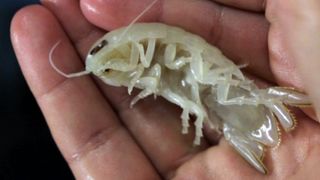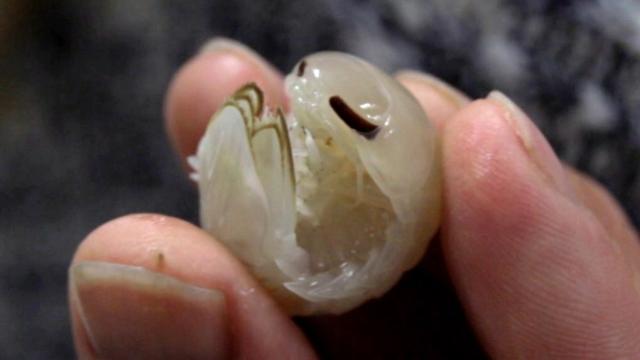Using LED lights and glow sticks, scientists in the Bahamas have discovered an ancient deep-sea crustacean with giant eyes and a see-through body.
Although the species, which they named Booralana nickorum, is newly identified, it has been on the planet for 300 million years and may play a crucial role in maintaining the health of the ecosystem, the researchers wrote in a study published Jan. 12 in the journal Zootaxa.

The new species named, Booralana nickorum, may play a crucial role in maintaining the health of the ecosystem. (Image credit: Courtesy of OceanX)
The new species has a hard exoskeleton; a segmented body; and big, compound eyes to find potential prey. As it lives in the deep sea, where there’s very little light, it has no need for color or pigmentation, so it’s white, and even slightly translucent.
“You can see its guts and things,” study co-author Nicholas Higgs, director of research and innovation at the Cape Eleuthera Institute, told Live Science.
At around 2.2 to 3 inches (55 to 76 millimeters) long, it’s much larger than its terrestrial cousins in the pill bug family — also called roly poly bugs or woodlice — which measures around 0.55 inch (14 mm). B. nickorum’s large size gives the deep-sea scavenger an advantage as it waits on the seabed for food to fall from above.
“The bigger you are, the more you can get from any one meal,” Higgs said, and the longer the animal can last between meals, which is important in this environment, where food is scarce.
The team discovered B. nickorum at depths of between about 1,770 and 1,840 feet (540 to 560 meters) on an underwater slope in the Bahamas’ Exuma Sound. They obtained the specimens during two expeditions, in April 2014 and February 2019, operated by OceanX and the Cape Eleuthera Institute. In 2014, they put down baited eel traps, which caught deep-sea isopods — a type of crustacean with a flattened, segmented body — so they returned in 2019 to investigate further using light traps. Instead of bait, these units had a flashing, multicolor LED fishing light; a green glow stick: a green, deep-drop LED fishing light; and a programmable white LED light to attract creatures by mimicking the bioluminescence generated by deep-sea animals.
Booralana nickorum was discovered during two expeditions to an underwater slope in the Bahamas’ Exuma Sound. (Image credit: Courtesy of OceanX)
As soon as the researchers examined the specimens on board the ship, they were confident that the species was “definitely different from anything we’ve seen before,” Higgs said.
Further tests confirmed that B. nickorum was a new species. It was named after two members of senior author Edward Brooks’ family, both called Nicholas Brooks.
These isopods play a critical role in the ecosystem by speeding up the decomposition of plant or animal matter so the wider ecosystem can benefit from these energy sources. “Otherwise, it would just sink down and remain locked away in the sediment,” Higgs said.
These crustaceans also ensure that the carbon within the organic matter falling from the shallows is captured in the deep ocean for thousands of years.
Finding new species like these helps researchers understand whether animals in the deep ocean are endemic to one place or disperse from one region to another over time. This enables scientists to better predict the ripple effect of human activities, such as mining. “If you impact one site, is that going to impact animals in a different area?” Higgs said.
With more countries like the Bahamas considering deep-sea oil exploration, Higgs believes expeditions like these are vital in helping decision-makers understand how drilling could affect their precious ecosystems.
“As long as we don’t have access to this environment,” he said, “we’re not going to appreciate it, we’re not going to understand it, and we’re not going to value it.”






